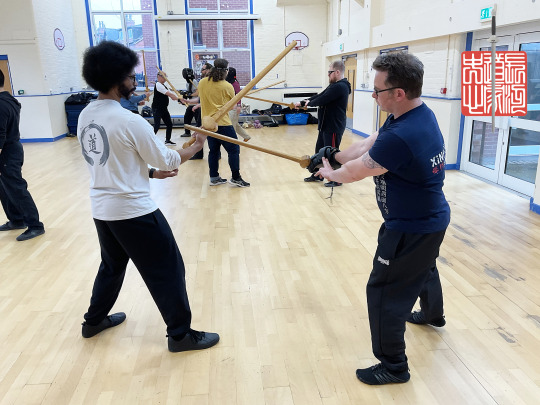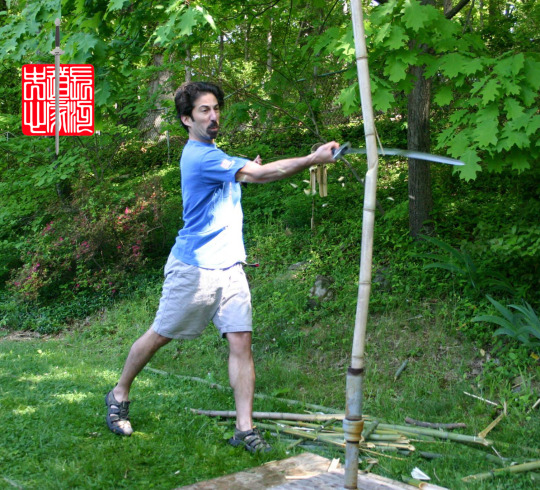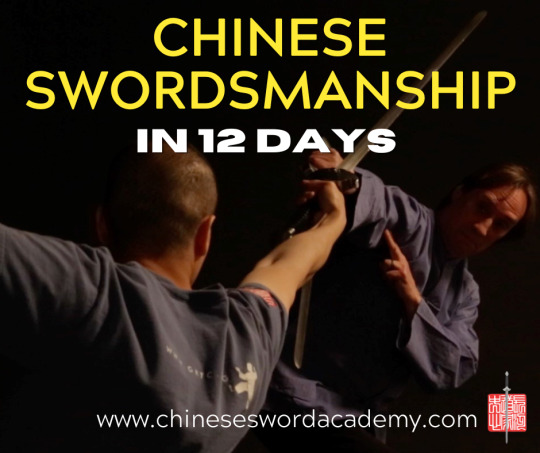#daoistswordsman
Explore tagged Tumblr posts
Text

We Need Your Input!
Hey everyone! We're reaching out to our current and potential students about Chinese swordsmanship. We want to make our classes and resources better for you.
What's Stopping You?
What are the main obstacles or issues you're facing in learning Chinese swordsmanship? Is it finding time, understanding the techniques, or something else? Let us know in the comments.
Your Feedback Matters
Your feedback is crucial. It helps us understand what you need and how we can improve. So, please, take a moment to tell us about your challenges.
Join the Conversation
If you haven't joined us yet, this is your chance to be part of a community that's all about learning and growing in Chinese swordsmanship. We're here to help each other. Join the Practical Chinese Swordsmanship Facebook group: https://www.facebook.com/groups/chineseswordacademy
Thanks for helping us make the Academy of Chinese Swordsmanship the best place to learn and practice this art.
#chineseswordfighting#chineseswordsmanship#jianfa#duanbing#chinesemartialarts#chineseswordplay#jianshu#scottmrodell#chinesemartialart#chineseswordarts#daoistswordarts#daoistswordsman#swordfightingschool#swordfightingskills#swordfightingclasses#scottrodell#ukchineseswordfighting#chineseswordwork#taijijian#taijiswordfencing#taijisword#taichisword#wudangsword#wudangjian#楊家秘傳太極劍#kungfuweapons#yangstyletaichichuan#yangstyletaichi#太極劍#taijifencing
2 notes
·
View notes
Photo

Musing over twists and turns, if I find the right tree, perhaps a Ponderosa Pine... my brush work is definitely in need of practice...
3 notes
·
View notes
Text
Training is a Treasure.

#jianfa#chineseswordsmanship#chineseswordfighting#scottmrodell#chinesemartialarts#duanbing#chinesemartialart#chineseswordplay#jianshu#daoistswordsman#daoistswordarts#yangjiamichuantaijijian#taijisword#taichisword#wudangsword#wudangjian#taijijian#chinesemartials#chineseswordarts#swordarts#taijiswordfencing#chineseswordfencing#ukchineseswordfighting#swordplay#swordwork#swordworkout#chineseswordwork#scottrodell#swordfightingschool#swordfightingclasses
4 notes
·
View notes
Text

Love my Jian, but sometimes you just gotta Miaodao…
#chineseswordsmanship#chineseswordfighting#chineseswordplay#chinesemartialarts#duanbing#swordplay#chinesemartialart#scottmrodell#miaodao#scottrodell#swordsmanship#historicalswordsmanship#swordfightingschool#swordfightingskills#swordfightingclasses#swordfighting#chineseswordwork#swordwork#daoistswordsman#swordfighter#dandaofaxuan#dandao#chineselongsword#刀法#中國刀法#daofa#苗刀
2 notes
·
View notes
Photo


Thanks to Apprentice Students Paul Andrews and Gavin King for once again helping out at the Leeds Chinese Sword Academy GRTC Seminar last weekend in Leeds, UK. The 1st Photos shows Gavin King, sporting his GRTC Manchu Shirt instructs new students in the basic Ci (Thrust Drill), and the proper deflection with the Blade Flat. In the 2nd Photo, Paul Andrews in blue executes a Pi Cut to Tom Daley's wrist as he controls the centerline.
#zhongguojianfa#jianfa#jianshu#scottrodell#scottmrodell#chineseswordsmanship#historicalswordsmanship#swordsmanship#chineseswordplay#swordplay#duanbing#chineseswordwork#swordwork#daoistswordarts#chineseswordart#swordarts#swordart#yangjiamichuantaijijian#taijijian#daoistswordsman#daoistsword#taijiswordfencing#taijisword#wudangjian#wudangsword#chinesemartialarts#chinesemartialart#swordfighter#swordfightingschool#swordfightingskills
5 notes
·
View notes
Text
Quick Draw with the Rodell Cutting Jian -
Some 5 plus years ago, I began working on reconstructing Chinese Fast Drawing Techniques. Here’s my early effort.
Thoughts on Sword Tricks...
During my winter break from seminars, I thought I would have some fun and try my hand at a few sword tricks from different traditions. In all honesty, some of the tricks preformed are essentially just that, tricks. What I mean by that is that they do not embody any skill a swordsman might actually use in a duel. And so, they don’t provide the swordsman with any useful training. They are just for entertainment.
When I started practicing throwing an apple in the air, cutting it, I was thinking it was just a trick and it might even be fairly criticized as showing off. (I bought a bag of small wiffle balls to practice with in the wuguan. I didn’t want to waste food). And there is certainly a trick to this trick. You have to throw the ball or apple where you can cut it. You have to practice throwing the same height each time too, so that he pacing is always about the same. You have to practice the timing of the throw and draw. It is easy to watch the ball or apple too long and draw late. So as I practiced, usually in the short time after dinner and before students arrived for the evening classes, I observed other useful aspects of this practice. For example, the delay I mentioned. You cannot separate watching the target and cutting. When you do, the body and mind and essentially separate for a moment. When you start to cut, there is a delay, and you tend to miss.
As when shooting arrows, if you start thinking about how you are doing well after hitting several in a row, your mind is elsewhere and you are probably going to miss the next one. There is also a tendency to over swing after the cut. This is a common error in most students’ cutting. The control of the after cut is the most difficult aspect of good cutting technique. If you let yourself start chasing the ball, you tend to swing like you are trying to hit it out of the park.
In a way, practicing cuts That one normally would not is like any different sort of training that takes one out of comfortable territory. Any sort of new cutting provides a fresh look at one’s skills. A fresh opportunity to critique one’s practice. So in hindsight, I am finding sword tricks I did for amusement to be an unexpected and useful test of my skills. Not in the sense that these are difficult or physically demanding cuts, but in the sense that they gave me a clean look at my practice. In a way, what does it matter if a cut is just a “trick?” Perhaps what is more important is how one makes use of practice time?
Then again, no big deal, baseball players hit balls all the time.
#jianfa#chineseswordsmanship#chinesemartialarts#duanbing#scottmrodell#daoistswordsman#chinesesword#chineseswordarts#taijijian#taijiswordfencing#taijisword#chineseswordfencing#chineseswordplay#testcutting#tameshigiri#swordclass#swordfightingskills#swordfightingart#swordfightingschool#wudangjian#kungfuweapons#chinesemartialart#chineseswordfighting#jianshu#yangjiamichuantaijijian#yangstylestaijiquan#yangfamilytaijiquan
1 note
·
View note
Video
youtube
Scott M. Rodell Unboxes a New Dadao Sparring Sword from Santosh Weapons After his Weekly Webinar. --- https://www.facebook.com/santosh_weap...
LIMITED OFFER - 50% OFF - The Complete Practical Dadao Form The Practical Dadao System was developed for Chinese Soldiers during the Early Republic and designed to meet a bayonet head on. At that time, military rifles only carried 5 rounds and were slow to reload. Every army of the period drilled bayonet fighting extensively. The Chinese answered by drawing on their long tradition of two-handed saber fighting. In this course, you will learn the entire Practical Dadao Form (實用大刀術), created by Jin Enzhong, to train troops. Every Form lesson is followed by an in-depth presentation of the Martial Applications of the movements facing a bayonet. Basic Cuts and Solo Drills are also covered. Jin published his manual in 1933. SIGN UP HERE - USE CODE Dadao50 for 50% off the course:
https://www.chineseswordacademy.com/practicaldadaocourse
#dadao#chineseswordsmanship#scottrodell#scottmrodell#historicalswordsmanship#chineseswordarts#chineseswordart#daoistswordsman#chinesemartialarts#chinesemartialart#kungfuweapons#swordfighter#swordfightingschool#swordfightingskills#swordtraining#swordclasses#swordclass#chineselongsword#刀法#中國刀法
4 notes
·
View notes
Video
youtube
Intercepting: Jie and Ge Cuts- Chinese Swordsmanship Webinar Excerpt
Looking for a systematic method to move from Forms Only Practice to Full On Free Swordplay? It's here >>>====> https://www.chineseswordacademy.com/membershipsandcourses Online & In-Person Training. Use Code: cut50 for Half Off the First Two Months.
#chinesswordsmanship#zhongguojianfa#jianfa#jianshu#yangstyle#yangstyletaichi#taijisword#taijijian#taichisword#wudangsword#wudangjian#swordclass#swordclasses#swordfightingskills#swordfightingschool#duanbing#daoistsword#daoistswordsman#daoistswordarts#swordarts#swordart#chineseswordart#chineseswordarts#scottrodell#scottmrodell#fullcontact#swordplay#chineseswordplay#chineseswordfighting#swordfighting
13 notes
·
View notes
Video
youtube
Scott M. Rodell presents the history and how-to of Chinese Fast Sword Drawing (出手法) and the techniques for re-scabbarding Jian. Get Started in Full Contact Swordplay, Online, and In-Person-
https://www.chineseswordacademy.com/membershipsandcourses
Use Code: cut50 for Half Off the First Two Months
#出手法#楊家秘傳太極劍#太極劍#swordclasses#swordclass#swordtraining#swordfightingskills#swordfightingschool#swordfighter#chinesemartialarts#chinesemartialart#wudangsword#wudangjian#taichisword#taijisword#taijijian#yangjiamichuantaijijian#daoistswordarts#daoistswordsman#daoistswordart#daoistsword#chineseswordarts#chineseswordart#swordart#swordarts#sword#swords#chineseswordwork#swordwork#duanbing
8 notes
·
View notes
Photo

Running Spearman
Context can be everything... During Academy of Chinese Swordsmanship Webinars, we often look at Daofa applications in an almost dueling like setting, one on one. Daofa however, was more of a military/battlefield art. Men were often in tight lines or other formations, or as this page from the Bing Lu (���录) illustrates, charging. Many of the movements we see in various forms make more sense if the spearman you are facing is charging, even at a slow run run.
#chineseswordsmanship#historicalswordsmanship#swordsmanship#chineseswordfighting#ukchineseswordfighting#swordfightingskills#swordfightingschool#swordfighting#chineseswordplay#swordplay#duanbing#chineseswordwork#swordwork#daoistswordarts#chineseswordart#swordart#swordarts#daoistswordsman#daoistsword#chinesemartialarts#chinesemartialart#swordfighter#chinesespear#swordclasses#swordclass#chineselongsword#中國刀法#刀法#苗刀#chineseswordsman
4 notes
·
View notes
Photo

Dry bamboo is pretty much the most challenging target. This one is not even pegged down. >>>=====> Also a great photo for the few left who think that you cannot cut with a jian because it is a thrust-centric weapon. Note the flex of the jian, demonstrating the stress of the impact on the blade. Photo is of Great River Taoist Center student Cutting in the Wuguan’s garden.
https://www.chineseswordacademy.com/
#zhongguojianfa#jianfa#historicalswordsmanship#chineseswordsmanship#swordsmanship#chineseswordfighting#swordfighting#chineseswordplay#swordplay#duanbing#chineseswordwork#swordwork#daoistswordarts#chineseswordart#swordarts#swordart#daoistswordsman#daoistsword#yangjiamichuantaijijian#taijijian#taijisword#taichisword#wudangjian#wudangsword#chinesemartialarts#chinesemartialart#swordfighter#swordtraining#swordfightingschool#swordfightingskills
6 notes
·
View notes
Photo

I put together 8 Short Sword Forms for the Academy of Chinese Swordsmanship (中華刀劍武藝學院). I drew them from the Yangjia Michuan Taiji Sword form, compacting some of the movements so they are practiced as they are applied in Free Swordplay.Sunday we worked on the 4th in the Series which starts squatting down then spring up to deliver the thrust seen here-White Ape Emerges from the Cave For more about the Academy see: https://www.chineseswordacademy.com/
#楊家秘傳太極劍#中國劍法#劍法#太極劍#劍術#swordclass#swordtraining#swordfightingskills#swordfightingschool#swordfighter#chinesemartialart#chinesemartialarts#wudangsword#wudangjian#taichisword#taijisword#yangjiamichuantaijijian#taijijian#daoistswordarts#daoistswordsman#daoistsword#chineseswordarts#swordarts#chineseswordwork#swordwork#duanbing#chineseswordplay#swordplay#historicalswordsmanship#chineseswordfighting
12 notes
·
View notes
Photo

Chinese Swordsmanship in 12 Days FREE ONLINE COURSE
Launching Friday October 7 Pre-Register here: https://www.chineseswordacademy.com/12DayCourseReg Interested in Historical Chinese Swordsmanship? Our new online introductory course "Chinese Swordsmanship in 12 Days" launches next week! This short course is made up of daily lessons with Scott M, Rodell and will introduce you to three iconic Chinese swords (Jian, Dao, and Miaodao) and the principles of full contact swordplay. Here's what you'll be learning: Day 1 - Jump Straight into Your First Cuts Day 2 - Grips - Jian, Dao, & Miaodiao Day 3 - Jian Ready Stance Day 4 - Thrusting with a Jian Day 5 - Cutting with a Jian Day 6 - Daofa Basic Stances Day 7 - Cutting with a Dao Day 8 - Stepping for Power in Daofa Day 9 - Miaodao Basic Stances Day 10 - Deflect & Cut with a Miaodao Day 11 - Miaodao - Slipping the Line Day 12 - Swordplay Strategies Scott M. Rodell is a martial artist, author, and teacher of Yang style Taijiquan. He is an internationally recognized expert of Chinese historical swordsmanship. Best known for his work reviving Chinese Historical Swordsmanship, he is widely considered the father of the renaissance of this art. Rodell travels frequently to Europe, across the US, and to Australia and Canada to lead seminars.
Pre-Book your FREE place: https://www.chineseswordacademy.com/12DayCourseReg
#juniorjianfa#zhongguojianfa#jianfa#jianshu#scottrodell#scottmrodell#historicalswordsmanship#chineseswordsmanship#swordsmanship#ukchineseswordfighting#chineseswordfighting#swordfightingskills#swordfightingschool#swordfightingclasses#swordfighting#duanbing#chineseswordwork#swordwork#daoistswordarts#daoistswordsman#daoistsword#yangjiamichuantaijijian#taijijian#taijisword#taichisword#swordclasses#swordclass#swordtraining#taijiswordfencing#wudangjian
3 notes
·
View notes
Photo

Criticism and Critiques
Many years ago, a classmate said to me, “It must be hard for you, it seems like Master Wang doesn’t like you.” We had just come out of a private meeting with our fellow disciple classmates. Somewhat surprised, I responded, “What do you mean?” He said Laoshi is always correcting you, criticizing you.” I said, that is because he cares about me and wants me to learn and improve. I pointed out that another classmate who had quit practicing, and quite literally achieve nothing, had simply been told, “It’s good you are back. You have your notes to work from.”
At another International event in Europe, where we were training outdoors, some students took a break, walked away from the group, sat down and smoked cigarettes. Wang Laoshi walked by and chatted friendly with them. He didn’t ask them what the hell was wrong with them? We had few opportunities to all work together and they were wasting time smoking of all things. No, he didn’t bother. I was teaching one group at the time. Master Wang turned saw me, observed the technique I was teaching and came over to critique what I was doing. I guess he liked the smokers better than me.
In all my years with Wang Yen-nien, he never complemented my technique or achievements in any way. Thankfully, he always told me what I was doing wrong and how to improve. I never needed to know what I was doing right, just what I could do better. And he clearly expected me to do better. He took the time to let me know that by being straight forward in his instructions to me. Thankfully he “didn’t like me” and criticized me all the time. Thanks to him, I am where I am now.
~ Scott M. Rodell
Photo: My teacher Wang Yen-nien writing “Perseverance” calligraphy that hangs at Great River Taoist Center
#yangstyle#yangstyletaichi#scottrodell#scottmrodel#wangyennien#楊家秘傳太極拳#yangjiamichuantaijiquan#daoistswordsman#gongfu#chineseswordarts#chineseswordart#taiji#taijiquan#swordandbrush#calligraphy#chinesebrush#chinesebrushwork#wenwu
5 notes
·
View notes
Video
tumblr
Students Training the Zha Ci Partner Drill
Leeds Chinese Swordsmanship Seminar, May 2022
Nice “skipping stone” movement where the deflection answers seamlessly with a Zha to the duifang’s sword arm, then continues in with a Ci to the sword arm shoulder as the arms is withdrawn.
One detail to note here is that some of the thrust are low and not to the shoulder as they should be. This error often occurs as the sword arms tires from a day of training. If the Ci goes too low, it should be deflected with a circular stirring deflection.
Thanks to Paul Andrew of the Xing Yi Academy for organizing our Leeds Seminars.
#楊家秘傳太極劍#太極劍#中國劍法#劍法#swordclass#swordclasses#swordtraining#swordfightingskills#swordfightingschool#swordfighter#chinesemartialart#chinesemartialarts#wudangsword#wudangjian#taichisword#taijisword#yangjiamichuantaijijian#taijijian#daoistswordarts#daoistswordsman#daoistswordman#daoistsword#chineseswordarts#chineseswordart#swordart#swordarts#swords#chineseswordwork#swordwork#duanbing
4 notes
·
View notes
Video
youtube
I hope you will enjoy my latest video- an Exceptional Qing Sword Cane, demonstrating its use. Full length Chinese Sword Canes are quite rare, and this one top quality in construction and handling. Looking for a systematic method to move from Forms Only Practice to Full On Free Swordplay? It's here- https://www.chineseswordacademy.com/membershipsandcourses
Online & In-Person Training. Use Code: cut50 for Half Off the First Two Months.
#zhongguojianfa#jianfa#scottrodell#scottmrodell#chineseswordsmanship#chineseswordfighting#historicalswordsmanship#chineseswordplay#swordcane#duanbing#chineseswordwork#chineseswordarts#chineseswordart#daoistswordsman#daoistswordarts#taijijian#taijisword#taichisword#chinesemartialarts#chinesemartialart#中國劍法#劍法#中國刀法#刀法#chineseswords#chinesesword
4 notes
·
View notes